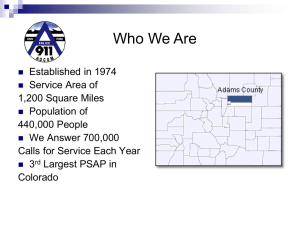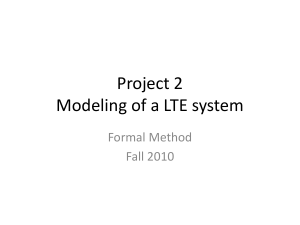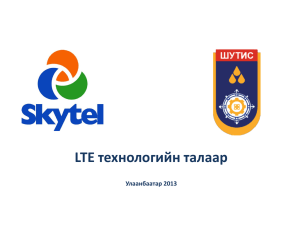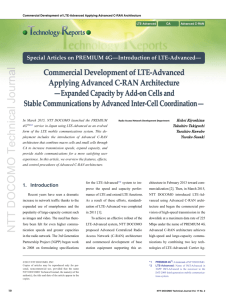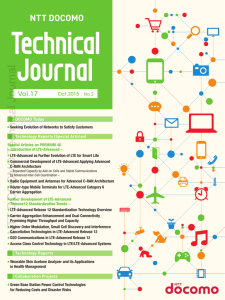LTE-Advanced as Further Evolution of LTE for Smart Life
advertisement
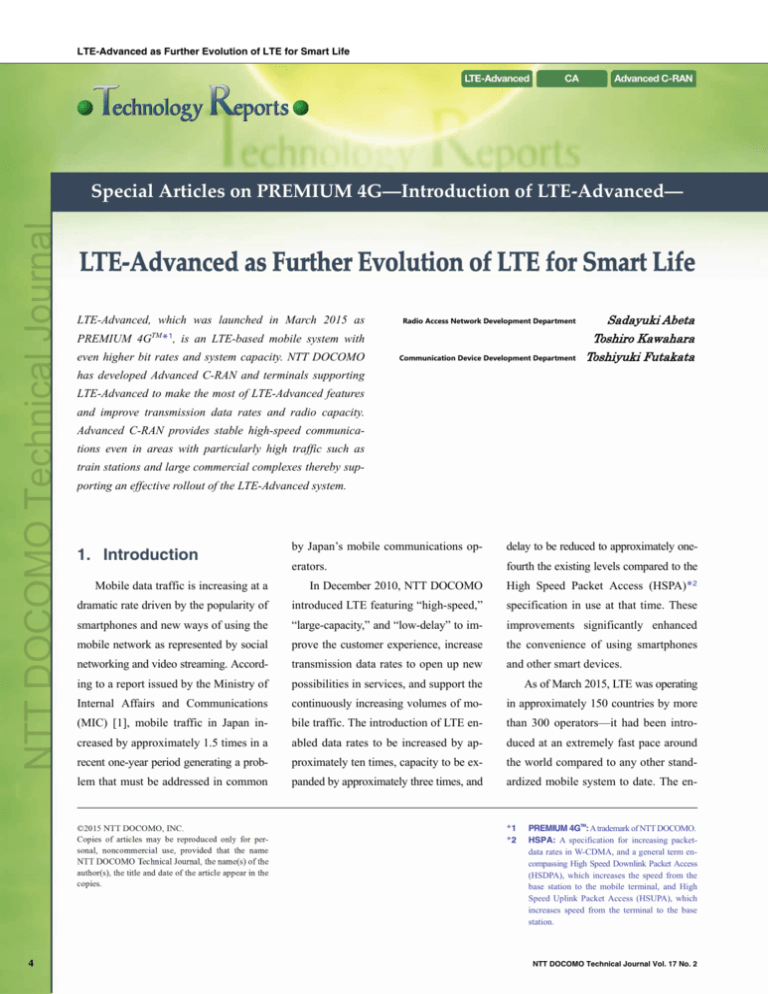
LTE-Advanced as Further Evolution of LTE for Smart Life LTE-Advanced CA Advanced C-RAN NTT DOCOMO Technical Journal Special Articles on PREMIUM 4G―Introduction of LTE‐Advanced― LTE-Advanced, which was launched in March 2015 as even higher bit rates and system capacity. NTT DOCOMO Communication Device Development Department Sadayuki Abeta Toshiro Kawahara Toshiyuki Futakata has developed Advanced C-RAN and terminals supporting LTE-Advanced to make the most of LTE-Advanced features and improve transmission data rates and radio capacity. Advanced C-RAN provides stable high-speed communications even in areas with particularly high traffic such as train stations and large commercial complexes thereby supporting an effective rollout of the LTE-Advanced system. 1. Introduction by Japan’s mobile communications op- delay to be reduced to approximately one- erators. fourth the existing levels compared to the Mobile data traffic is increasing at a In December 2010, NTT DOCOMO High Speed Packet Access (HSPA)*2 dramatic rate driven by the popularity of introduced LTE featuring “high-speed,” specification in use at that time. These smartphones and new ways of using the “large-capacity,” and “low-delay” to im- improvements significantly enhanced mobile network as represented by social prove the customer experience, increase the convenience of using smartphones networking and video streaming. Accord- transmission data rates to open up new and other smart devices. ing to a report issued by the Ministry of possibilities in services, and support the As of March 2015, LTE was operating Internal Affairs and Communications continuously increasing volumes of mo- in approximately 150 countries by more (MIC) [1], mobile traffic in Japan in- bile traffic. The introduction of LTE en- than 300 operators—it had been intro- creased by approximately 1.5 times in a abled data rates to be increased by ap- duced at an extremely fast pace around recent one-year period generating a prob- proximately ten times, capacity to be ex- the world compared to any other stand- lem that must be addressed in common panded by approximately three times, and ardized mobile system to date. The en- ©2015 NTT DOCOMO, INC. Copies of articles may be reproduced only for personal, noncommercial use, provided that the name NTT DOCOMO Technical Journal, the name(s) of the author(s), the title and date of the article appear in the copies. 4 Radio Access Network Development Department PREMIUM 4GTM*1, is an LTE-based mobile system with *1 *2 PREMIUM 4GTM: A trademark of NTT DOCOMO. HSPA: A specification for increasing packetdata rates in W-CDMA, and a general term encompassing High Speed Downlink Packet Access (HSDPA), which increases the speed from the base station to the mobile terminal, and High Speed Uplink Packet Access (HSUPA), which increases speed from the terminal to the base station. NTT DOCOMO Technical Journal Vol. 17 No. 2 NTT DOCOMO Technical Journal hanced form of LTE is LTE-Advanced, vanced as an enhancement of LTE began must exhibit a significant improvement which holds promise of being a vitally in June 2008 and LTE-Advanced re- in performance when connected to the important and influential technology in quirements were subsequently compiled LTE-Advanced network while being able society. in a 3GPP Technical Report [5]. In addi- to connect to the LTE network as well. NTT DOCOMO launched LTE-Ad- tion to coexistence with LTE, migration 2) Improvement in Peak Data Rate, vanced as a commercial service under scenario from LTE, and improved per- Spectral Efficiency, and Cell Edge the name “PREMIUM 4G” in March formance, a reduction in power and oper- User Throughput 2015. In this article, we present an over- ating costs was also included as one of LTE-Advanced must provide a dra- view of LTE-Advanced technologies and the requirements. Main requirements for matic improvement in basic system per- of our newly developed Advanced Cen- LTE-Advanced are described below. formance over LTE. The requirement for tralized Radio Access Network (C-RAN), 1) Coexistence with LTE peak data rate is 1 Gbps in the downlink and 500 Mbps in the uplink. which enables Carrier Aggregation (CA) LTE-Advanced is, of course, expected between cells, improves throughput while to surpass LTE in system performance, Additionally, LTE-Advanced is re- maintaining mobility characteristics, and but it must also enable a smooth migra- quired to improve spectral efficiency by increases capacity. Other special articles tion from existing LTE. In short, back- approximately 1.5 times over LTE. Con- in this issue provide details on control ward and forward compatibility with sidering that LTE-Advanced require- schemes and equipment in Advanced C- LTE is a key requirement. ments were established right after the RAN and on mobile terminal technol- Here, we define backward and for- approval of LTE itself, this requirement ogies supporting LTE-Advanced [2]–[4]. ward compatibility in terms of terminal for improved spectral efficiency was a capabilities as shown in Figure 1. First, very challenging target. 2. LTE-Advanced Requirements A specifications study for LTE-Ad- LTE terminals must naturally be able to Cell edge user throughput was also connect to the LTE-Advanced network, taken up as an important performance and second, LTE-Advanced terminals index. This is because throughput at cell LTE base station LTE terminal LTE-Advanced station EPC LTE terminal LTE-Advanced terminal LTE-Advanced terminal LTE and LTE-Advanced compatibility LTE base station LTE-Advanced station LTE base station LTE LTE LTE-Advanced terminal LTE LTE-Advanced EPC : Evolved Packet Core Figure 1 NTT DOCOMO Technical Journal Vol. 17 No. 2 LTE-Advanced compatibility 5 LTE-Advanced as Further Evolution of LTE for Smart Life edge is an important factor in providing [6]. The use of CA enables higher data (HetNet) is also attracting attention. a sufficiently satisfactory service to a rates to be achieved while maintaining HetNet appropriately deploys and coor- cell-edge user whose received quality is backward compatibility with existing dinates base stations of various form fac- low due to a weak radio signal and in- LTE. It also enables instantaneous load tors and power levels including the small terference from other cells. In LTE, as balancing*4 cell*11 with the aim of lowering costs. well, cell edge user throughput is an im- to improve spectral efficiency. between frequency bands Radio interfaces that can efficiently sup- NTT DOCOMO Technical Journal portant index, but in LTE-Advanced, technologies that could improve throughput especially in such a cell-edge envi- 3.2 Advanced Multi-antenna Technology ronment were a focus of study. junction with CA, enhanced Inter-Cell Interference Coordination (eICIC) that MIMO*5 mitigates intra-frequency interference, multiplexing for up to 4 layers* in the and such have been specified for HetNet. LTE supports single-user 6 3. Main Technologies of LTE-Advanced downlink but supports no MIMO multi- To satisfy the requirements described Advanced supports single-user MIMO above for LTE-Advanced, further ad- multiplexing for up to 8 layers in the Although further advancements in vancements in radio interface technolo- downlink and up to 4 layers in the uplink data rates can be achieved using CA as gies were proposed as described below. to satisfy requirements for peak spec- one of the main technologies of LTE- plexing in the uplink. In contrast, LTE- tral efficiency*7. 4. Features of Advanced C-RAN Architecture In addition, multi-user Advanced, technology than can increase has been enhanced in LTE- capacity for the environments with ex- For a maximum bandwidth of 20 MHz, Advanced to improve system capacity. ceptionally large volumes of traffic, such LTE achieves a peak data rate of 300 Furthermore, to improve cell edge user as the neighborhood surrounding a major Mbps in the downlink by supporting throughput, Coordinated Multiple Point train station, is particularly important. 4×4 Multiple Input Multiple Output transmission and reception (CoMP) tech- Such an environment requires not only (MIMO)*3 technology. In contrast, a nology has been proposed as a means of the use of more frequencies to accommo- peak data rate of 1 Gbps in the downlink performing transmission and reception date traffic but also an increase in an and 500 Mbps in the uplink has been via multiple cells working in coopera- area capacity by deploying small cells, specified as a requirement for LTE-Ad- tion [6]. as part of HetNet. However, user move- 3.1 CA MIMO*8 ment in such an environment increases vanced, so the provision of even broader bandwidths is needed. LTE-Advanced, however, must also ensure backward 3.3 Base Station Coordination in HetNet compatibility with LTE. For this reason, HandOver (HO)*12 occurrences either between small cells or between a macro In LTE-Advanced, lowering the cost cell and small cell, which may cause CA was proposed as a means of band- of the Radio Access Network (RAN)* width extension achieved by combining is also an important requirement. In ad- Moreover, while higher transmission multiple frequency blocks, each of which dition to the conventional deployment data rates and improved user throughput 9 higher probability of call drop. is called a Component Carrier (CC) of macro base stations, imple- by load balancing between frequency having a bandwidth supported by LTE mentation of a Heterogeneous Network blocks can be expected with introduction MIMO: A technology for achieving high-speed transmission by simultaneously transmitting different signals from multiple antennas. Load balancing: The process of reducing load between frequencies or cells by moving users accordingly. Single-user MIMO: Technology that uses MIMO transmission over the same time and frequency for a single user. Layer: In MIMO, each layer corresponds to a stream—multiple streams may be simultaneously transmitted. Peak spectral efficiency: Maximum spectral efficiency that can be achieved according to specifications. Maximum rate efficiency. Multi-user MIMO: Technology that uses MIMO transmission over the same time and frequency for multiple users. RAN: The network consisting of radio base stations and radio-circuit control equipment situated between the core network and mobile terminals. *10 Macro cell: An area in which communication is possible, covered by a single base station, and with a radius from several hundred meters to several tens of kilometers. *11 Small cell: Generic name for a cell covering a small area and having low transmission power relative to a macro cell. *3 *4 *5 *6 6 port inter-frequency coordination in con- *7 *8 *9 cell*10 NTT DOCOMO Technical Journal Vol. 17 No. 2 lizing CA and HetNet features. fic frequency resources to perform CA (1) High-speed transmission through CA (3) Greater capacity through add-on cells are likely to be completely utilized, which Increases transmission data rates Improves user throughput in both makes it difficult to achieve a significant in a flexible manner depending on macro cells and small cells by ar- improvement in spectral efficiency. the current traffic environment by CA ranging add-on cells effectively in In light of the above, NTT DOCOMO between macro cells and between areas with high traffic and offloading proposed Advanced C-RAN architec- macro cell and multiple add-on cells. traffic as needed thereby increasing ture (Figure 2) in March 2012 [7] and (2) Comparable mobility characteristics as a conventional macro cell commenced its development in 2013. capacity over the entire area. 5. Rollout Scenario Advanced C-RAN architecture adds a Maintains the same rate of HO number of small cells on top of a macro occurrence as in a conventional con- Since 2009, NTT DOCOMO has cell (hereinafter referred to as “add-on figuration with only macro cells by been deploying an centralized RAN (C- cells”) and coordinates the add-on cells adding or deleting add-on cells while RAN) architecture for LTE in which and the macro cell through CA. maintaining macro-cell connection. baseband*13 processing is performed in Advanced C-RAN architecture has This scheme achieves conventional central node, and radio units may be the following features achieved by uti- mobility performance even in an en- distributed in different location connect- Achieves CA between a macro cell and multiple add-on cells by adding small cells inside the macro cell in a high-traffic area Consolidates baseband processing to perform control operations Achieves CA by overlapping macro cell Frequency bandwidth NTT DOCOMO Technical Journal vironment with add-on cells. of CA, at the base station with high traf- CA Compact radio unit CA HO Figure 2 NTT DOCOMO Technical Journal Vol. 17 No. 2 CA HO Macro cell *12 HO: A technology for switching base stations without interrupting communications when a terminal with a call in progress straddles two base stations while moving. Achieves CA by spot deployment of a small cell Small cell Baseband unit Advanced C-RAN architecture *13 Baseband: The circuits or functional blocks that perform digital signal processing. 7 ed to the baseband unit via optical fiber radio unit operates on one of these car- [8]. This made it easy to construct a net- riers, and since these radio units are in- work that can make the most of the fea- dependent of their common baseband This article presented an overview tures described above by simply replac- unit, it is relatively easy to combine any of LTE-Advanced technologies reflect- ing the baseband processing unit with of these carriers. At the time of LTE- ing the ongoing evolution of LTE and new equipment supporting Advanced C- Advanced introduction, a total band- introduced Advanced C-RAN as network RAN without touching the existing radio width greater than 30 MHz could be architecture for making the most of units. achieved by combining the 800 MHz LTE-Advanced features. Approximately We have also been developing radio and 1.7 GHz carriers or the 2 GHz and five years after the introduction of LTE, equipment for add-on cells that is far 1.5 GHz carriers making for a maximum NTT DOCOMO launched LTE-Advanced lighter and smaller than existing equip- throughput greater than 225 Mbps. services under the banner of PREMIUM 6. Conclusion ment [3]. Specifically, we have been able Going forward, the plan is to use a 4G in March 2015 to improve the user to reduce the size of this equipment to combination of three component carriers experience even further. Looking to the 1/5 that of existing units, which has the (3CC) in conjunction with Time Division future, NTT DOCOMO aims to con- effect of relaxing installation conditions Duplex on the newly allocated tribute to society by expanding the service for these radio units and broadening their 3.5 GHz carrier and to apply advances area and enhancing its lineup of mobile scope of application. in MIMO technology to achieve even devices, and by providing a new and NTT DOCOMO had already been higher transmission data rates and greater fertile social infrastructure as a Smart operating LTE on four carriers, and these capacities. The ultimate goal here is to Life Partner. frequencies have to be used effectively. improve the user’s quality of experience In Advanced C-RAN architecture, each (Figure 3). (TDD)*14 More advanced LTE Peak throughput NTT DOCOMO Technical Journal LTE-Advanced as Further Evolution of LTE for Smart Life ・Use of 3.5 GHz band ・3CC CA – Full LTE (2×2 MIMO) 150Mbps 112.5Mbps LTE service launched 37.5/75Mbps Dec. 2010 ・4×4 MIMO – LTE-Advanced introduction 225 Mbps and greater Mar. 2015 Figure 3 Toward more advanced LTE *14 TDD: A bidirectional transmit/receive system. It achieves bidirectional communication by allocating different time slots to uplink and downlink transmissions that use the same frequency band. 8 NTT DOCOMO Technical Journal Vol. 17 No. 2 REFERENCES Technical Journal, Vol.17, No.2, pp.10- Universal Terrestrial Radio Access (E- [1] Ministry of Internal Affairs and Commu- 18, Oct. 2015. UTRA) (LTE-Advanced),” 2009. nications (MIC), Information and Com- [3] T. Yoshihara et al.: “Radio Equipment [6] 3GPP TR36.814 V9.0.0: “Further Advance- munications Statistics Database: “In- and Antennas for Advanced C-RAN ments for E-UTRA Physical Layer As- formation and Communications Traffic Architecture,” NTT DOCOMO Technical in Japan” (in Japanese). Journal, Vol.17, No.2, pp.19-24, Oct. http://www.soumu.go.jp/johotsusintokei/ NTT DOCOMO Technical Journal field/data/gt010602.pptx 2015. [4] H. Suzuki et al.: “Router-type Mobile pects,” 2010. [7] S. Abeta and H. Atarashi: “Radio Access Network for Ultra High Speed Broadband Services,” Proc. of the IEICE Gen- [2] K. Kiyoshima et al.: “Commercial Devel- Terminals for LTE-Advanced Category eral Conference, Mar. 2012 (in Japanese). opment of LTE-Advanced Applying Ad- 6 Carrier Aggregation, NTT DOCOMO [8] Y. Shimazu et al.: “RRE Shared between W- vanced C-RAN Architecture—Expanded Technical Journal, Vol.17, No.2, pp.25- CDMA and LTE Systems,” NTT DOCOMO Capacity by Add-on Cells and Stable 30, Oct. 2015. Technical Journal, Vol.12, No.1, pp.29-33, Communications by Advanced Inter- [5] 3GPP TR36.913 V8.0.1: “Requirements Cell Coordination—,” NTT DOCOMO for further advancements for Evolved NTT DOCOMO Technical Journal Vol. 17 No. 2 Jun. 2010. 9
